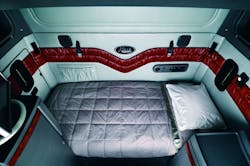A recent study by the University of Kentucky’s College of Public Health concludes that the lack of safety restraint is the main factor in injury severity to truck drivers and passengers in commercial vehicle crashes, rather than the location of drivers and passengers within the cab.
Indeed, non-use of occupant restraints is the primary reason sleeper berth occupants are injured or killed in a severe crash,Dr. Terry Bunn, director of the Kentucky Injury Prevention and Research Center and an author of the study, told Fleet Owner.
The other risk factor found to increase the odds of injury to a truck driver or passenger is the area of first contact in the collision – especially the front or side of the vehicle, she said.
Bunn said the study reviewed 708 semi-truck collisions involving a passenger in the sleeper berth compartment in Kentucky between 2000 and 2010 to determine if passengers in the sleeper berth were at higher risk of injury in a collision compared to semi-truck drivers.
The study’s results indicate that seating position is not a significant factor associated with an injury in a moving truck collision; rather, the lack of restraint use by both types of occupants was the main determining factor related to injury severity.
Bunn suggested that commercial vehicle carriers should implement and enforce a workplace policy that requires all vehicle occupants – drivers and sleeper berth passengers alike – to use occupant safety restraints while the semi-truck is moving.
However, she stressed that the study’s research team also informally polled 20 truck drivers to discern why sleeper-berth restraints are not used more frequently and came up with several reasons.
“The main reason is that [sleeper berth] restraints restrict movement and impede good sleep, as they are ‘too tight’ on occupants, especially if the truck driver is large,” Bunn noted. “They say they feel like they’re sleeping in a cargo net.”
Other reasons include the fear of being trapped due to the strict restraining nature of the occupant restraint system, especially in case of fire or rollover, as well as the belief that using such devices isn’t necessary.
Bunn noted that while federal laws require all drivers, including commercial vehicle drivers, to wear seat belts while operating a motor vehicle, there no known laws requiring the use of occupant safety restraints in the sleeper berth.
“Occupant restraints in the sleeper berth have been required since 1971 but they are not widely used,” she added. “Police officers should be made aware that all semi cabs contain occupant restraint systems [as] many officers do not realize that sleeper berths contain occupant restraint systems.”
Bunn also recommended – based on the results from her study – that state laws should be passed to require the use of occupant restraint systems within the sleeper berth similar to drivers in other motor vehicles.
“We would also recommend that a traffic violation for non-use of the occupant restraint system be considered a primary violation, not a secondary violation, in the case of crashes,” she pointed out.
Bunn also noted that the design of sleeper berth restraints hasn’t changed significantly in the last 40 years. “Truck drivers say they will use them if they are comfortable [so] one way to improve comfort is to have them snap from roof to floor instead of across the body,” she said.
Finally, Bunn suggested that mandatory occupant restraint system usage should be mandated by trucking company policy, while such devices also need to be redesigned to make them more “user friendly” in terms of comfort but still retaining function. “The use of occupant restraint systems needs to be emphasized as part of the trucker safety culture,” she added.
About the Author
Sean Kilcarr
Editor in Chief
Sean Kilcarr is a former longtime FleetOwner senior editor who wrote for the publication from 2000 to 2018. He served as editor-in-chief from 2017 to 2018.
